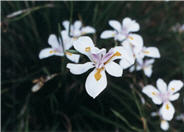
Common name:Lamb's Ear
Botanical name:Stachys byzantina
This tiny shrub will grow less than 1' tall and has medium-size, greyish-green leaves with blue and lavender flowers that bloom in the spring. This shrub is grown more for its velvety leaves than the flowers. It is drought tolerant once it's established. Be careful not to overwater.

Common name:Dwarf Oakleaf Hydrangea
Botanical name:Hydrangea quercifolia 'Pee Wee'
And upright shrub with large maple like leaves. It has a very graceful form and it has wonderful white flowers in the spring. The plant is worth adding for the foliage alone but the blooms are to die for.

Common name:Butterfly Iris or Fortnight Lily
Botanical name:Dietes iridioides
This clumping evergreen iris bears tall, narrow leaves to 30" tall and white flowers marked purple in the center on stalks to 3' tall, appearing spring through fall. This variety has stiffer, darker foiliage than the bicolor form. It requires sun to part shade with little or no summer watering when established. This is a very reliable plant. Divide every 3-5 years to keep it looking fresh.

Common name:Evergreen Clematis
Botanical name:Clematis armandii
A climbing evergreen vine, this Clematis may reach a size of 20'-30'. Its dark green, slender leaflets have a leathery texture, and produce fragrant, showy white flowers in the spring. It tolerates sun or part shade, drought, moist soil, and prefers shade around its roots. It attracts beneficial insects and hummingbirds.
- Cornflower Farms
More than half of the water used at your home is for outside purposes. Studies show that on average, half of the water used outdoors is wasted. The leading cause of waste is incorrectly set and poorly managed irrigation controllers. The second biggest cause of wastage is broken irrigation equipment that goes undetected. There are a few basic things you can do to make a big difference in your water use.
Click in the green box for more information
Designer:
Photographer: GardenSoft
Incorporate compost 6" into your soil to retain water, reduce compaction, feed earthworms, and provide valuable nutrients to your plants.
Attract, or buy beneficial insects such as ladybugs and lacewings to control pest outbreaks in your garden.